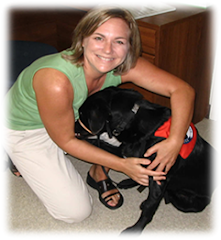
One of the biggest assets of using a dog in therapy is that they motivate the clients to participate in activities. Over the years, I've seen clients who normally refuse to participate in traditional therapy become completely animated and involved in a therapy session with a dog. This same person, who would normally avoid traditional therapy techniques to increase their range of motion will take a brush and brush a large dog from head to tail (accomplishing the task but in a motivating way!). It's quite inspiring to watch!!
I've been seeing a young boy, named Sammy, for over a year now for difficulties with fine motor skills, visual motor coordination, spatial awareness, and motor coordination. Some of the biggest things we are working on involve handwriting and the coordination needed to recreate a design that he sees. Sammy has difficulty with spatial awareness, which translates to difficulty with orientation to the writing baseline or spacing in or between the letters of words. When we started, Sammy reversed many of his letters and didn't even know how to form his letters. he is now writing simple sentences on adaptive paper to help him with spatial awareness.
Over this time, Sammy and I have struggled to get him to the point where he enjoys to write. Previously, handwriting was very difficult for him, and he had difficulties with reversing his letters. After months of visual motor activities and visual perception, we are finally to the point of getting ready to discharge Sammy. But, writing is still one of his least favorite things to do, so I have to find ways to make it interesting for him, so he will do it. I've been letting him choose his own topic, which gives him a sense of self in the assignment, and I've also asked him to increase the number of sentences he writes. We started at 3 sentences, and initially it took him the full 30min. session to write these sentences. Gradually, over the last several months, we have increased the number of sentences and tried to decrease the time, as his parents report that homework takes him literally hours to do. Sammy is easily distracted from task, which is why things often take him so long.
However, when he arrived on Thursday, I asked him if he would mind if Chief joined us in the therapy room. Sammy is a BIG animal lover, and of course, he was very excited. We did the formal introductions between Sammy and Chief, got the excitement for the 2 contained, and then started to work on Sammy's writing. Sammy immediately told me he wanted to write about Chief. He quickly decided the sentences he wanted to write and began his story. After 10 min., Sammy handed me his finished product (pictured above). It was AMAZING!! I had to help him very little with sentence development or even noticing when he made a mistake. Sammy found his OWN errors in his writing (another big feat!!). The only assistance I gave him was spelling unknown words (such as Golden Retriever and Saluki...).
The bottom line of what happened, Chief was inspiration to Sammy to write. Sammy was excited about the dog being in the room and had a story he wanted to share. Because he was interested in the topic, Sammy's focus and attention to task was significantly improved. Research has shown that when we are interested in a topic, we are better focused and more learning occurs. Then, because I had promised him he could do something with Chief when he was done, Sammy was determined to get his assignment done in a timely manner, so he could enjoy some quality time with the dog.
I think Chief had a profound impact on Sammy's therapy session. Good on you, Chief!!! :)
Tammy



1 comment:
Great blog post -- thanks for sharing "concrete" evidence that working with animals can be a huge plus in therapy! I would like to link to this post from my site for others to read.
Post a Comment